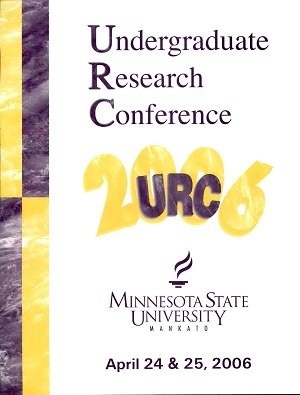A Faunal Analysis of the Silvernale Site, Goodhue, Mn; Features 1 and 2
Location
CSU North Ballroom
Start Date
24-4-2006 10:30 AM
End Date
24-4-2006 12:30 PM
Student's Major
Anthropology
Student's College
Social and Behavioral Sciences
Mentor's Name
Ronald Schirmer
Mentor's Department
Anthropology
Mentor's College
Social and Behavioral Sciences
Description
Throughout time people have utilized both animal and plant resources and the methods that they used are unique to their time, place and season. By understanding the ways in which specific groups of people utilized the animal remains it provides additional techniques to aid in interpretation of a co-habited archaeological site. These techniques while not new have not been utilized in the analysis of many sites. The analysis of faunal remains from the Silvemale site plays a vital role in the interpretation of the archaeological site because in this case, by identifying what faunal material a group of people were utilizing it narrows down the seasons in which they were living on the land and the time and continuity across the archaeological site. The material was collected from the archaeological site Silvemale which is located in Goodhue, MN. The faunal material recovered from the site mainly consisted of mammal, avian, reptilian and fish bone. Remains were recovered through a collection of soil samples, cleaned using a floatation machine, and then broken down into four main categories: charcoal, lithic debitage (the flakes of rock cast off from shaping stone), pottery and fauna. Visual analysis identified the bone fragments and the data tabulated to aid in providing further context for the site. These techniques of indicating seasonality by interpreting the animal remains is a valuable contribution to understanding subsistence and the archaeological site as a whole.
A Faunal Analysis of the Silvernale Site, Goodhue, Mn; Features 1 and 2
CSU North Ballroom
Throughout time people have utilized both animal and plant resources and the methods that they used are unique to their time, place and season. By understanding the ways in which specific groups of people utilized the animal remains it provides additional techniques to aid in interpretation of a co-habited archaeological site. These techniques while not new have not been utilized in the analysis of many sites. The analysis of faunal remains from the Silvemale site plays a vital role in the interpretation of the archaeological site because in this case, by identifying what faunal material a group of people were utilizing it narrows down the seasons in which they were living on the land and the time and continuity across the archaeological site. The material was collected from the archaeological site Silvemale which is located in Goodhue, MN. The faunal material recovered from the site mainly consisted of mammal, avian, reptilian and fish bone. Remains were recovered through a collection of soil samples, cleaned using a floatation machine, and then broken down into four main categories: charcoal, lithic debitage (the flakes of rock cast off from shaping stone), pottery and fauna. Visual analysis identified the bone fragments and the data tabulated to aid in providing further context for the site. These techniques of indicating seasonality by interpreting the animal remains is a valuable contribution to understanding subsistence and the archaeological site as a whole.
Recommended Citation
Halling, Christine. "A Faunal Analysis of the Silvernale Site, Goodhue, Mn; Features 1 and 2." Undergraduate Research Symposium, Mankato, MN, April 24, 2006.
https://cornerstone.lib.mnsu.edu/urs/2006/poster-session-A/5




